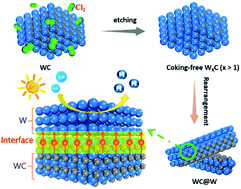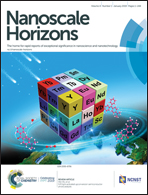Realizing the extraction of carbon from WC for in situ formation of W/WC heterostructures with efficient photoelectrochemical hydrogen evolution†
Abstract
Although extracting carbon atoms from carbides, as the reverse route to carbide derived carbon (CDC), may have more potentials for constructing advanced nanostructures, it has not been realized yet. As a proof of concept, in this work we realize the extraction of carbon atoms from carbide lattices by rationally controlling the reaction between carbides and Cl2. Thus, a homologous metallic W layer adhered on a WC (W/WC) heterostructure is created. Based on experimental results, such a W/WC heterostructure can be used as an efficient catalyst for the photoelectrocatalytic hydrogen evolution reaction (HER), where the photocurrent density at 0 V can reach up to 16 mA cm−2. Our theoretical calculations disclose that the Mott–Schottky effect accelerates electron flow across the interfaces and significantly decreases the work function of the W facet, which leads to excellent photoelectrocatalytic HER activity on the W facets. The presented results have broad implications since they demonstrate the generic capability to build homologous M/TMC heterostructures.



 Please wait while we load your content...
Please wait while we load your content...